Analysis of Research Questions on Nursing Student Communication
VerifiedAdded on 2022/08/21
|7
|1573
|26
Homework Assignment
AI Summary
This assignment analyzes a research article that explored the experiences of nursing students when communicating with patient family members. The study, using a qualitative approach with interviews, aimed to understand the students' perspectives on effective communication and the emotional impact of these interactions. The analysis addresses key research questions regarding the study's aims, methodology, research design, recruitment strategy, data collection, ethical considerations, data analysis rigor, findings, and overall value. The research highlights the importance of effective communication in patient-centered care, emphasizing the need for nursing students to build trust and improve the quality of care through direct involvement of family members. The analysis also discusses limitations and potential improvements, such as including family members in the interviews and conducting comparative studies with registered nurses, to achieve less biased and more comprehensive results. The document provides a detailed evaluation of the research process, from the clarity of the research questions to the rigor of the data analysis, and its overall contribution to the field of nursing education.
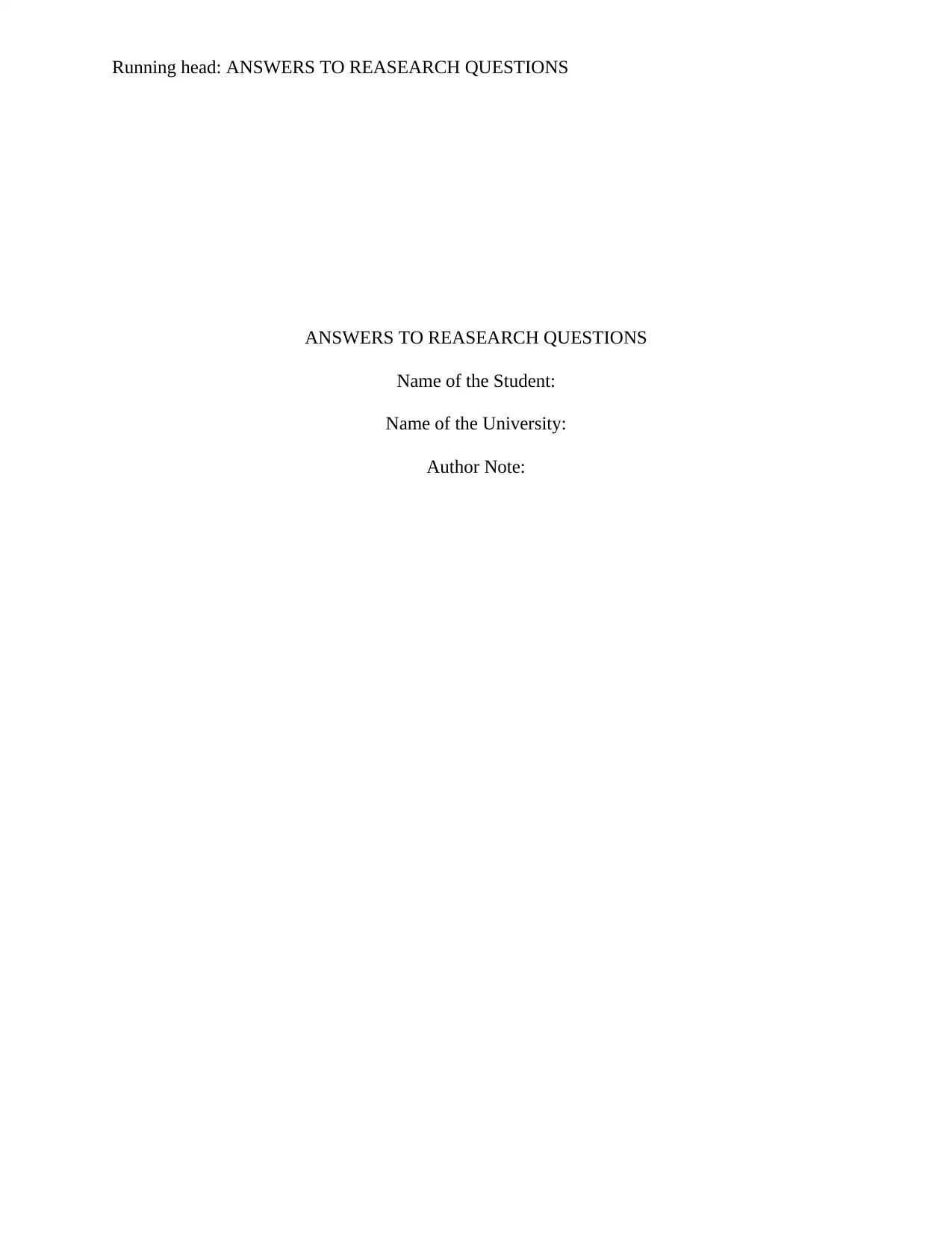
Running head: ANSWERS TO REASEARCH QUESTIONS
ANSWERS TO REASEARCH QUESTIONS
Name of the Student:
Name of the University:
Author Note:
ANSWERS TO REASEARCH QUESTIONS
Name of the Student:
Name of the University:
Author Note:
Paraphrase This Document
Need a fresh take? Get an instant paraphrase of this document with our AI Paraphraser
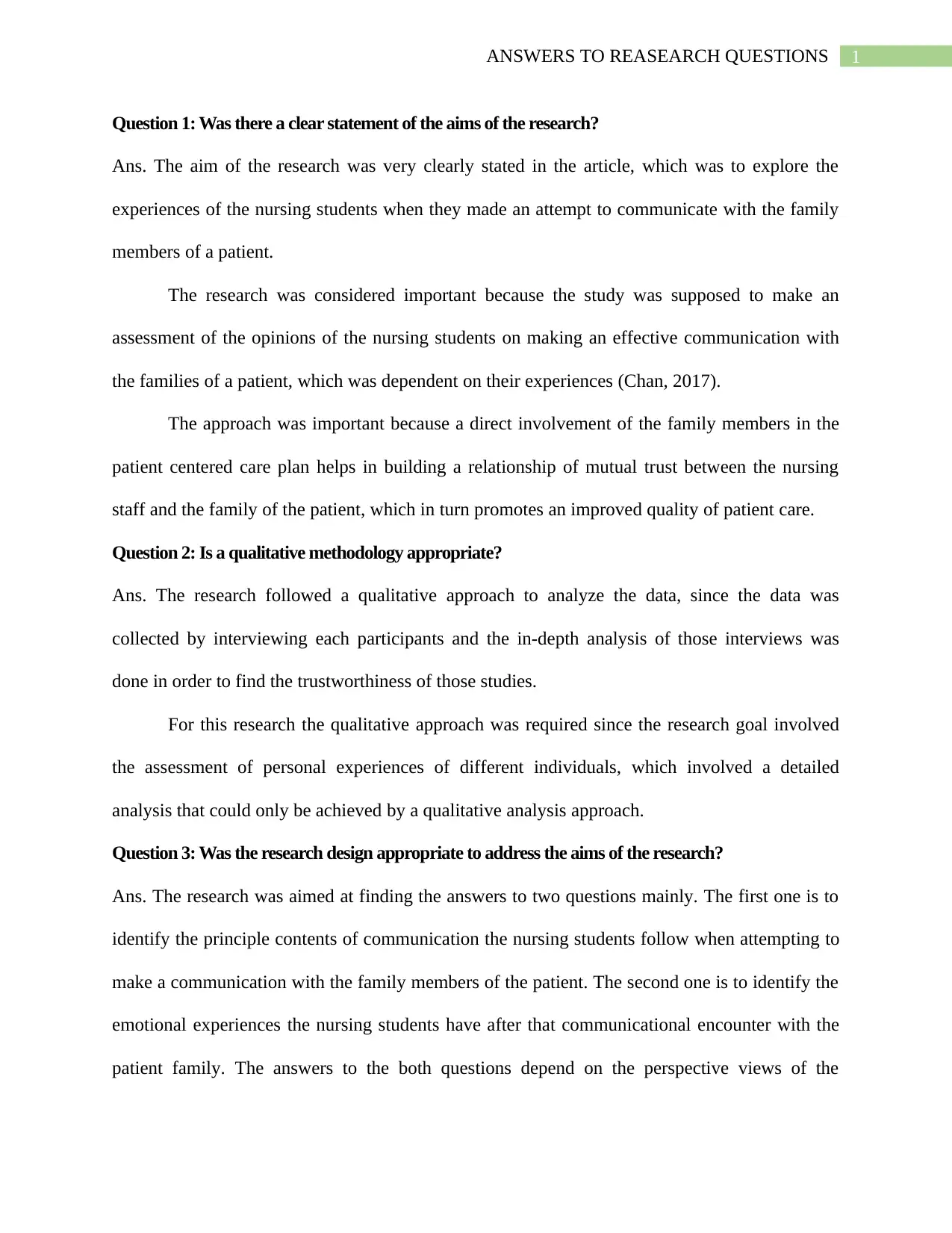
1ANSWERS TO REASEARCH QUESTIONS
Question 1: Was there a clear statement of the aims of the research?
Ans. The aim of the research was very clearly stated in the article, which was to explore the
experiences of the nursing students when they made an attempt to communicate with the family
members of a patient.
The research was considered important because the study was supposed to make an
assessment of the opinions of the nursing students on making an effective communication with
the families of a patient, which was dependent on their experiences (Chan, 2017).
The approach was important because a direct involvement of the family members in the
patient centered care plan helps in building a relationship of mutual trust between the nursing
staff and the family of the patient, which in turn promotes an improved quality of patient care.
Question 2: Is a qualitative methodology appropriate?
Ans. The research followed a qualitative approach to analyze the data, since the data was
collected by interviewing each participants and the in-depth analysis of those interviews was
done in order to find the trustworthiness of those studies.
For this research the qualitative approach was required since the research goal involved
the assessment of personal experiences of different individuals, which involved a detailed
analysis that could only be achieved by a qualitative analysis approach.
Question 3: Was the research design appropriate to address the aims of the research?
Ans. The research was aimed at finding the answers to two questions mainly. The first one is to
identify the principle contents of communication the nursing students follow when attempting to
make a communication with the family members of the patient. The second one is to identify the
emotional experiences the nursing students have after that communicational encounter with the
patient family. The answers to the both questions depend on the perspective views of the
Question 1: Was there a clear statement of the aims of the research?
Ans. The aim of the research was very clearly stated in the article, which was to explore the
experiences of the nursing students when they made an attempt to communicate with the family
members of a patient.
The research was considered important because the study was supposed to make an
assessment of the opinions of the nursing students on making an effective communication with
the families of a patient, which was dependent on their experiences (Chan, 2017).
The approach was important because a direct involvement of the family members in the
patient centered care plan helps in building a relationship of mutual trust between the nursing
staff and the family of the patient, which in turn promotes an improved quality of patient care.
Question 2: Is a qualitative methodology appropriate?
Ans. The research followed a qualitative approach to analyze the data, since the data was
collected by interviewing each participants and the in-depth analysis of those interviews was
done in order to find the trustworthiness of those studies.
For this research the qualitative approach was required since the research goal involved
the assessment of personal experiences of different individuals, which involved a detailed
analysis that could only be achieved by a qualitative analysis approach.
Question 3: Was the research design appropriate to address the aims of the research?
Ans. The research was aimed at finding the answers to two questions mainly. The first one is to
identify the principle contents of communication the nursing students follow when attempting to
make a communication with the family members of the patient. The second one is to identify the
emotional experiences the nursing students have after that communicational encounter with the
patient family. The answers to the both questions depend on the perspective views of the
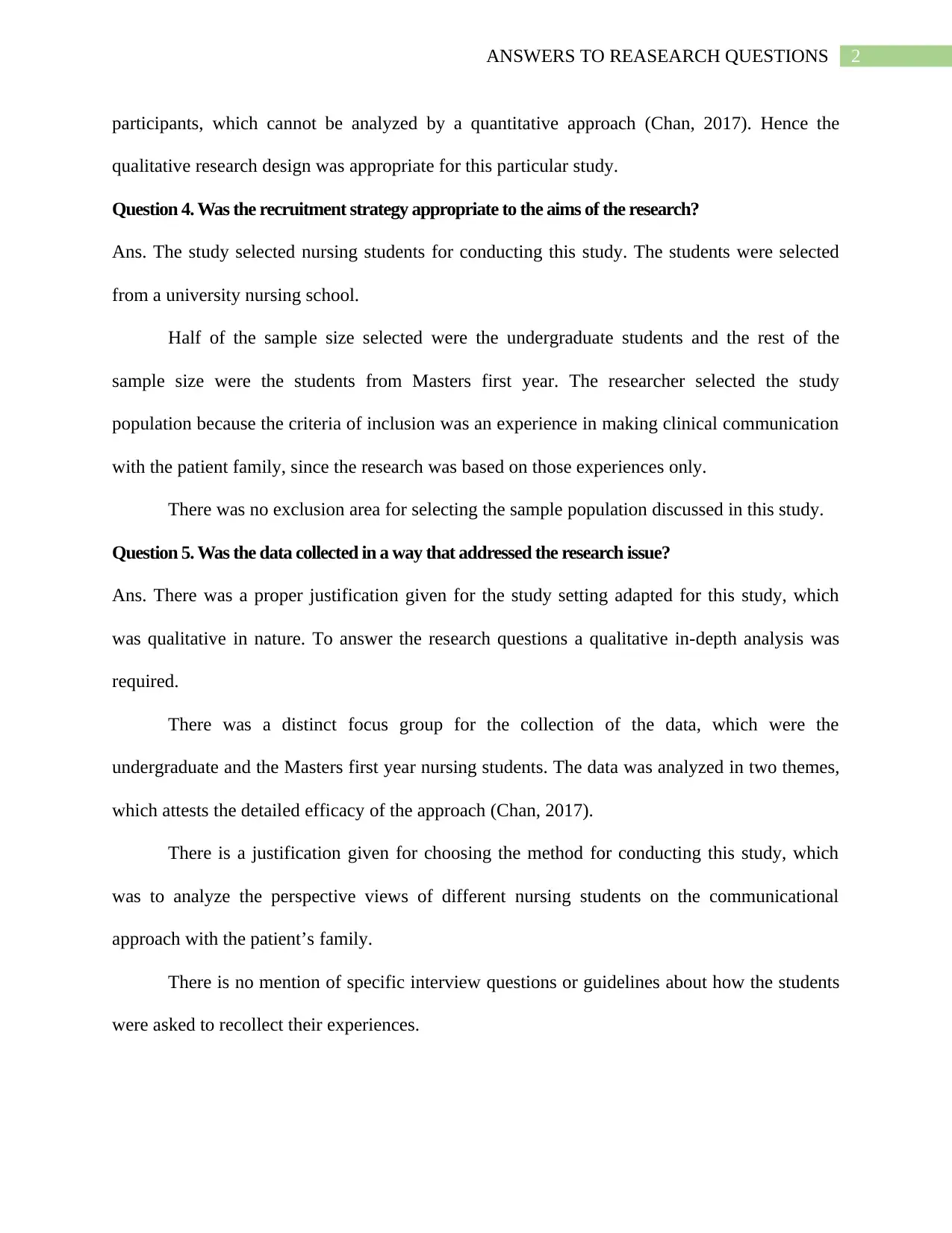
2ANSWERS TO REASEARCH QUESTIONS
participants, which cannot be analyzed by a quantitative approach (Chan, 2017). Hence the
qualitative research design was appropriate for this particular study.
Question 4. Was the recruitment strategy appropriate to the aims of the research?
Ans. The study selected nursing students for conducting this study. The students were selected
from a university nursing school.
Half of the sample size selected were the undergraduate students and the rest of the
sample size were the students from Masters first year. The researcher selected the study
population because the criteria of inclusion was an experience in making clinical communication
with the patient family, since the research was based on those experiences only.
There was no exclusion area for selecting the sample population discussed in this study.
Question 5. Was the data collected in a way that addressed the research issue?
Ans. There was a proper justification given for the study setting adapted for this study, which
was qualitative in nature. To answer the research questions a qualitative in-depth analysis was
required.
There was a distinct focus group for the collection of the data, which were the
undergraduate and the Masters first year nursing students. The data was analyzed in two themes,
which attests the detailed efficacy of the approach (Chan, 2017).
There is a justification given for choosing the method for conducting this study, which
was to analyze the perspective views of different nursing students on the communicational
approach with the patient’s family.
There is no mention of specific interview questions or guidelines about how the students
were asked to recollect their experiences.
participants, which cannot be analyzed by a quantitative approach (Chan, 2017). Hence the
qualitative research design was appropriate for this particular study.
Question 4. Was the recruitment strategy appropriate to the aims of the research?
Ans. The study selected nursing students for conducting this study. The students were selected
from a university nursing school.
Half of the sample size selected were the undergraduate students and the rest of the
sample size were the students from Masters first year. The researcher selected the study
population because the criteria of inclusion was an experience in making clinical communication
with the patient family, since the research was based on those experiences only.
There was no exclusion area for selecting the sample population discussed in this study.
Question 5. Was the data collected in a way that addressed the research issue?
Ans. There was a proper justification given for the study setting adapted for this study, which
was qualitative in nature. To answer the research questions a qualitative in-depth analysis was
required.
There was a distinct focus group for the collection of the data, which were the
undergraduate and the Masters first year nursing students. The data was analyzed in two themes,
which attests the detailed efficacy of the approach (Chan, 2017).
There is a justification given for choosing the method for conducting this study, which
was to analyze the perspective views of different nursing students on the communicational
approach with the patient’s family.
There is no mention of specific interview questions or guidelines about how the students
were asked to recollect their experiences.
⊘ This is a preview!⊘
Do you want full access?
Subscribe today to unlock all pages.

Trusted by 1+ million students worldwide
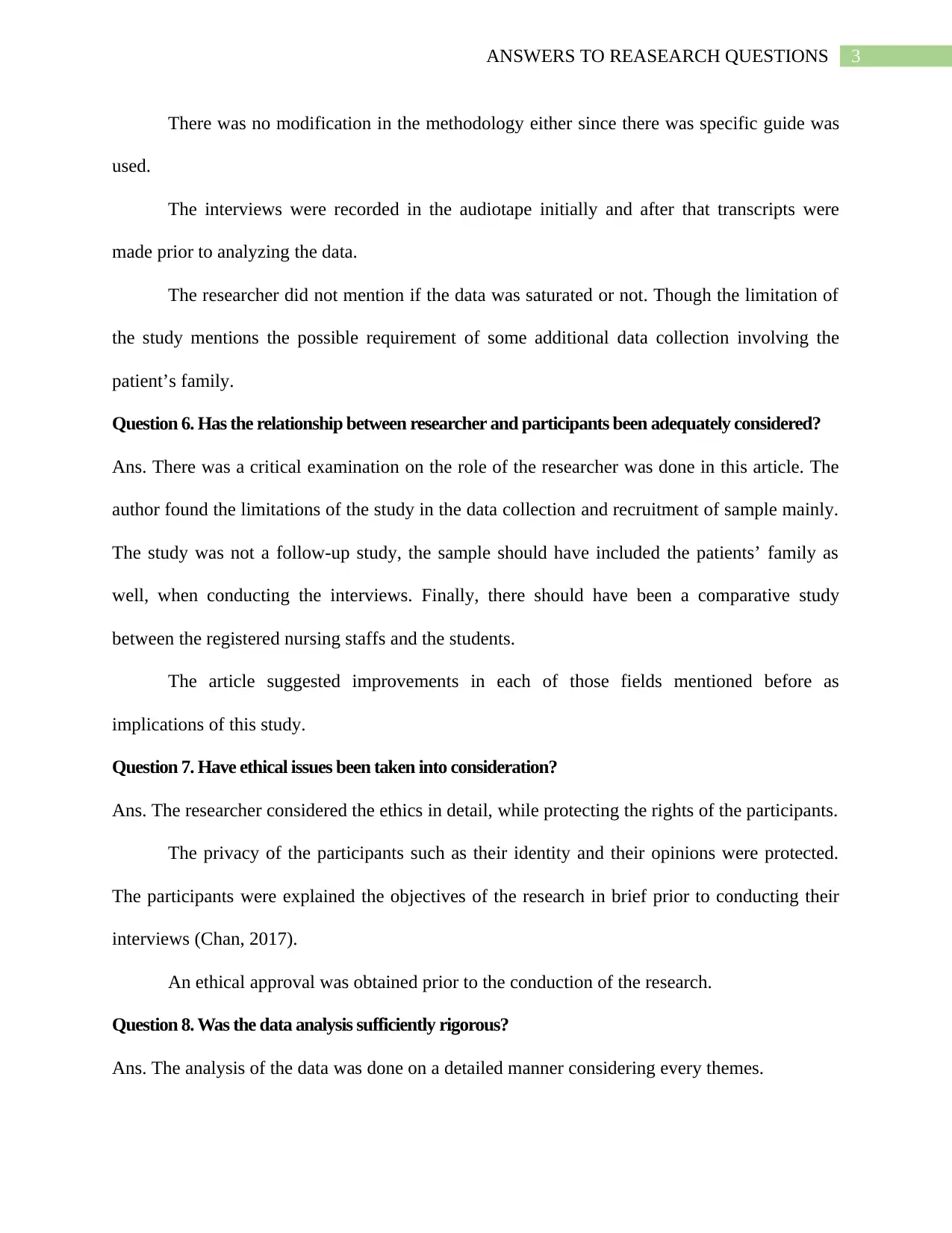
3ANSWERS TO REASEARCH QUESTIONS
There was no modification in the methodology either since there was specific guide was
used.
The interviews were recorded in the audiotape initially and after that transcripts were
made prior to analyzing the data.
The researcher did not mention if the data was saturated or not. Though the limitation of
the study mentions the possible requirement of some additional data collection involving the
patient’s family.
Question 6. Has the relationship between researcher and participants been adequately considered?
Ans. There was a critical examination on the role of the researcher was done in this article. The
author found the limitations of the study in the data collection and recruitment of sample mainly.
The study was not a follow-up study, the sample should have included the patients’ family as
well, when conducting the interviews. Finally, there should have been a comparative study
between the registered nursing staffs and the students.
The article suggested improvements in each of those fields mentioned before as
implications of this study.
Question 7. Have ethical issues been taken into consideration?
Ans. The researcher considered the ethics in detail, while protecting the rights of the participants.
The privacy of the participants such as their identity and their opinions were protected.
The participants were explained the objectives of the research in brief prior to conducting their
interviews (Chan, 2017).
An ethical approval was obtained prior to the conduction of the research.
Question 8. Was the data analysis sufficiently rigorous?
Ans. The analysis of the data was done on a detailed manner considering every themes.
There was no modification in the methodology either since there was specific guide was
used.
The interviews were recorded in the audiotape initially and after that transcripts were
made prior to analyzing the data.
The researcher did not mention if the data was saturated or not. Though the limitation of
the study mentions the possible requirement of some additional data collection involving the
patient’s family.
Question 6. Has the relationship between researcher and participants been adequately considered?
Ans. There was a critical examination on the role of the researcher was done in this article. The
author found the limitations of the study in the data collection and recruitment of sample mainly.
The study was not a follow-up study, the sample should have included the patients’ family as
well, when conducting the interviews. Finally, there should have been a comparative study
between the registered nursing staffs and the students.
The article suggested improvements in each of those fields mentioned before as
implications of this study.
Question 7. Have ethical issues been taken into consideration?
Ans. The researcher considered the ethics in detail, while protecting the rights of the participants.
The privacy of the participants such as their identity and their opinions were protected.
The participants were explained the objectives of the research in brief prior to conducting their
interviews (Chan, 2017).
An ethical approval was obtained prior to the conduction of the research.
Question 8. Was the data analysis sufficiently rigorous?
Ans. The analysis of the data was done on a detailed manner considering every themes.
Paraphrase This Document
Need a fresh take? Get an instant paraphrase of this document with our AI Paraphraser
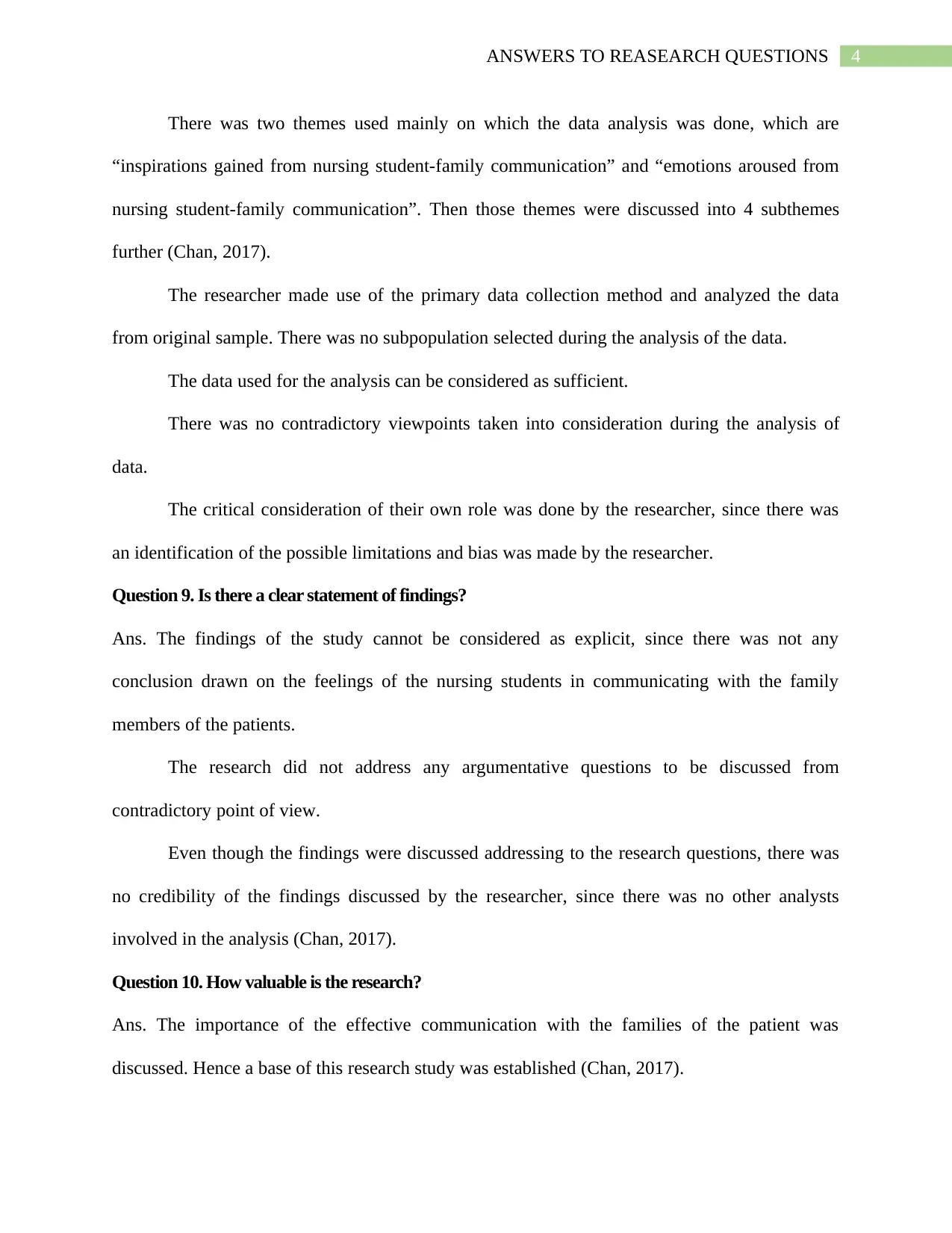
4ANSWERS TO REASEARCH QUESTIONS
There was two themes used mainly on which the data analysis was done, which are
“inspirations gained from nursing student-family communication” and “emotions aroused from
nursing student-family communication”. Then those themes were discussed into 4 subthemes
further (Chan, 2017).
The researcher made use of the primary data collection method and analyzed the data
from original sample. There was no subpopulation selected during the analysis of the data.
The data used for the analysis can be considered as sufficient.
There was no contradictory viewpoints taken into consideration during the analysis of
data.
The critical consideration of their own role was done by the researcher, since there was
an identification of the possible limitations and bias was made by the researcher.
Question 9. Is there a clear statement of findings?
Ans. The findings of the study cannot be considered as explicit, since there was not any
conclusion drawn on the feelings of the nursing students in communicating with the family
members of the patients.
The research did not address any argumentative questions to be discussed from
contradictory point of view.
Even though the findings were discussed addressing to the research questions, there was
no credibility of the findings discussed by the researcher, since there was no other analysts
involved in the analysis (Chan, 2017).
Question 10. How valuable is the research?
Ans. The importance of the effective communication with the families of the patient was
discussed. Hence a base of this research study was established (Chan, 2017).
There was two themes used mainly on which the data analysis was done, which are
“inspirations gained from nursing student-family communication” and “emotions aroused from
nursing student-family communication”. Then those themes were discussed into 4 subthemes
further (Chan, 2017).
The researcher made use of the primary data collection method and analyzed the data
from original sample. There was no subpopulation selected during the analysis of the data.
The data used for the analysis can be considered as sufficient.
There was no contradictory viewpoints taken into consideration during the analysis of
data.
The critical consideration of their own role was done by the researcher, since there was
an identification of the possible limitations and bias was made by the researcher.
Question 9. Is there a clear statement of findings?
Ans. The findings of the study cannot be considered as explicit, since there was not any
conclusion drawn on the feelings of the nursing students in communicating with the family
members of the patients.
The research did not address any argumentative questions to be discussed from
contradictory point of view.
Even though the findings were discussed addressing to the research questions, there was
no credibility of the findings discussed by the researcher, since there was no other analysts
involved in the analysis (Chan, 2017).
Question 10. How valuable is the research?
Ans. The importance of the effective communication with the families of the patient was
discussed. Hence a base of this research study was established (Chan, 2017).
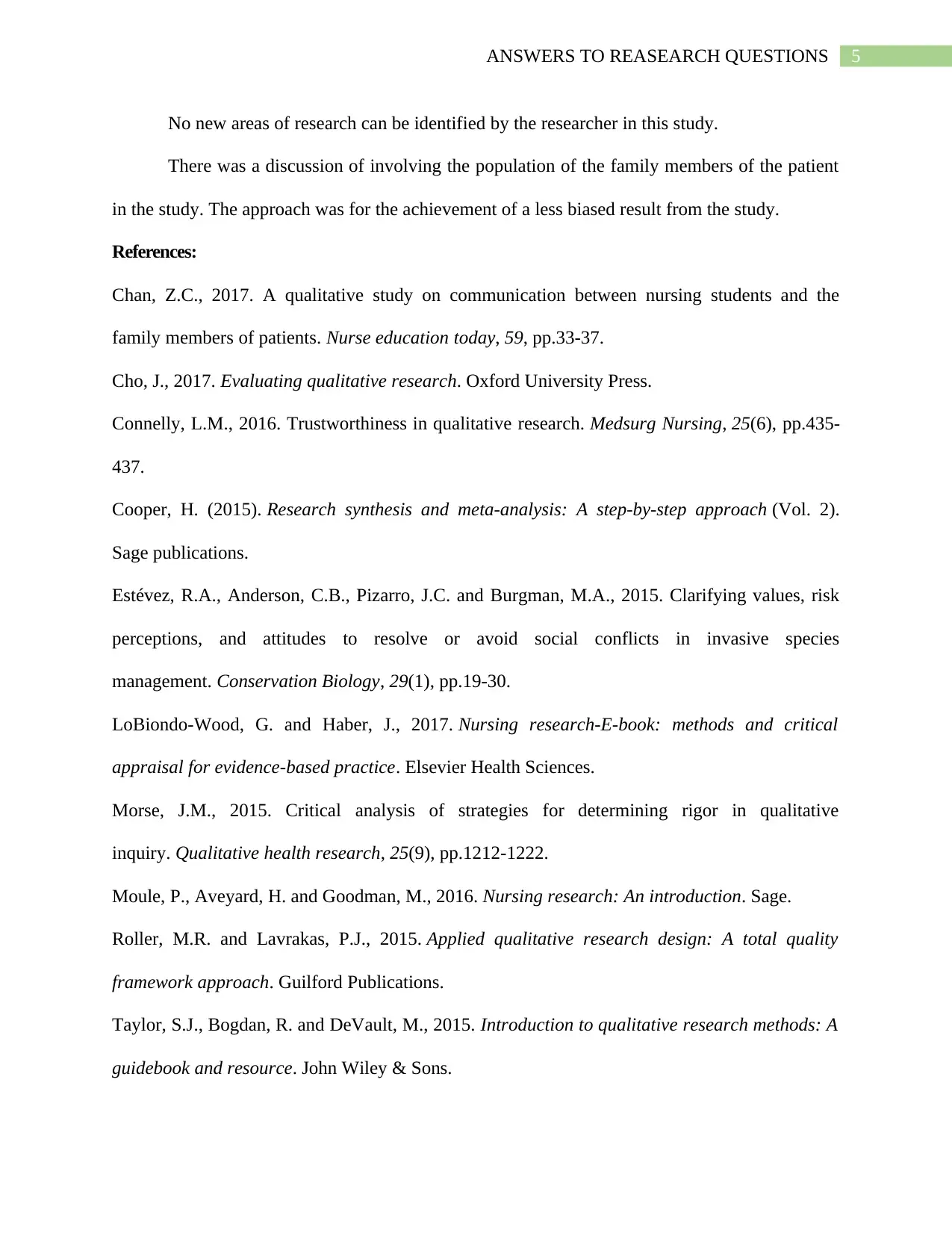
5ANSWERS TO REASEARCH QUESTIONS
No new areas of research can be identified by the researcher in this study.
There was a discussion of involving the population of the family members of the patient
in the study. The approach was for the achievement of a less biased result from the study.
References:
Chan, Z.C., 2017. A qualitative study on communication between nursing students and the
family members of patients. Nurse education today, 59, pp.33-37.
Cho, J., 2017. Evaluating qualitative research. Oxford University Press.
Connelly, L.M., 2016. Trustworthiness in qualitative research. Medsurg Nursing, 25(6), pp.435-
437.
Cooper, H. (2015). Research synthesis and meta-analysis: A step-by-step approach (Vol. 2).
Sage publications.
Estévez, R.A., Anderson, C.B., Pizarro, J.C. and Burgman, M.A., 2015. Clarifying values, risk
perceptions, and attitudes to resolve or avoid social conflicts in invasive species
management. Conservation Biology, 29(1), pp.19-30.
LoBiondo-Wood, G. and Haber, J., 2017. Nursing research-E-book: methods and critical
appraisal for evidence-based practice. Elsevier Health Sciences.
Morse, J.M., 2015. Critical analysis of strategies for determining rigor in qualitative
inquiry. Qualitative health research, 25(9), pp.1212-1222.
Moule, P., Aveyard, H. and Goodman, M., 2016. Nursing research: An introduction. Sage.
Roller, M.R. and Lavrakas, P.J., 2015. Applied qualitative research design: A total quality
framework approach. Guilford Publications.
Taylor, S.J., Bogdan, R. and DeVault, M., 2015. Introduction to qualitative research methods: A
guidebook and resource. John Wiley & Sons.
No new areas of research can be identified by the researcher in this study.
There was a discussion of involving the population of the family members of the patient
in the study. The approach was for the achievement of a less biased result from the study.
References:
Chan, Z.C., 2017. A qualitative study on communication between nursing students and the
family members of patients. Nurse education today, 59, pp.33-37.
Cho, J., 2017. Evaluating qualitative research. Oxford University Press.
Connelly, L.M., 2016. Trustworthiness in qualitative research. Medsurg Nursing, 25(6), pp.435-
437.
Cooper, H. (2015). Research synthesis and meta-analysis: A step-by-step approach (Vol. 2).
Sage publications.
Estévez, R.A., Anderson, C.B., Pizarro, J.C. and Burgman, M.A., 2015. Clarifying values, risk
perceptions, and attitudes to resolve or avoid social conflicts in invasive species
management. Conservation Biology, 29(1), pp.19-30.
LoBiondo-Wood, G. and Haber, J., 2017. Nursing research-E-book: methods and critical
appraisal for evidence-based practice. Elsevier Health Sciences.
Morse, J.M., 2015. Critical analysis of strategies for determining rigor in qualitative
inquiry. Qualitative health research, 25(9), pp.1212-1222.
Moule, P., Aveyard, H. and Goodman, M., 2016. Nursing research: An introduction. Sage.
Roller, M.R. and Lavrakas, P.J., 2015. Applied qualitative research design: A total quality
framework approach. Guilford Publications.
Taylor, S.J., Bogdan, R. and DeVault, M., 2015. Introduction to qualitative research methods: A
guidebook and resource. John Wiley & Sons.
⊘ This is a preview!⊘
Do you want full access?
Subscribe today to unlock all pages.

Trusted by 1+ million students worldwide
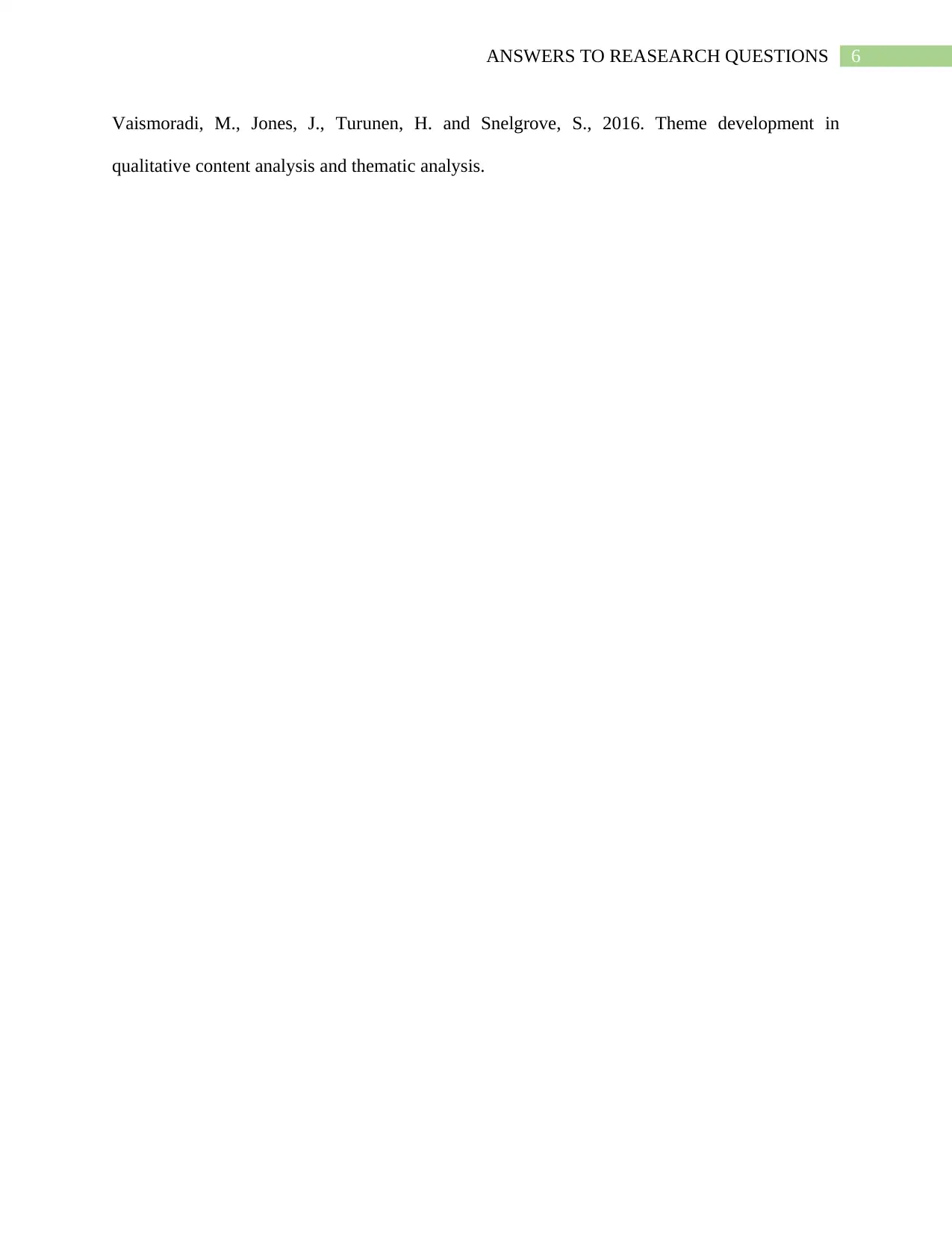
6ANSWERS TO REASEARCH QUESTIONS
Vaismoradi, M., Jones, J., Turunen, H. and Snelgrove, S., 2016. Theme development in
qualitative content analysis and thematic analysis.
Vaismoradi, M., Jones, J., Turunen, H. and Snelgrove, S., 2016. Theme development in
qualitative content analysis and thematic analysis.
1 out of 7
Related Documents
Your All-in-One AI-Powered Toolkit for Academic Success.
+13062052269
info@desklib.com
Available 24*7 on WhatsApp / Email
![[object Object]](/_next/static/media/star-bottom.7253800d.svg)
Unlock your academic potential
Copyright © 2020–2025 A2Z Services. All Rights Reserved. Developed and managed by ZUCOL.





